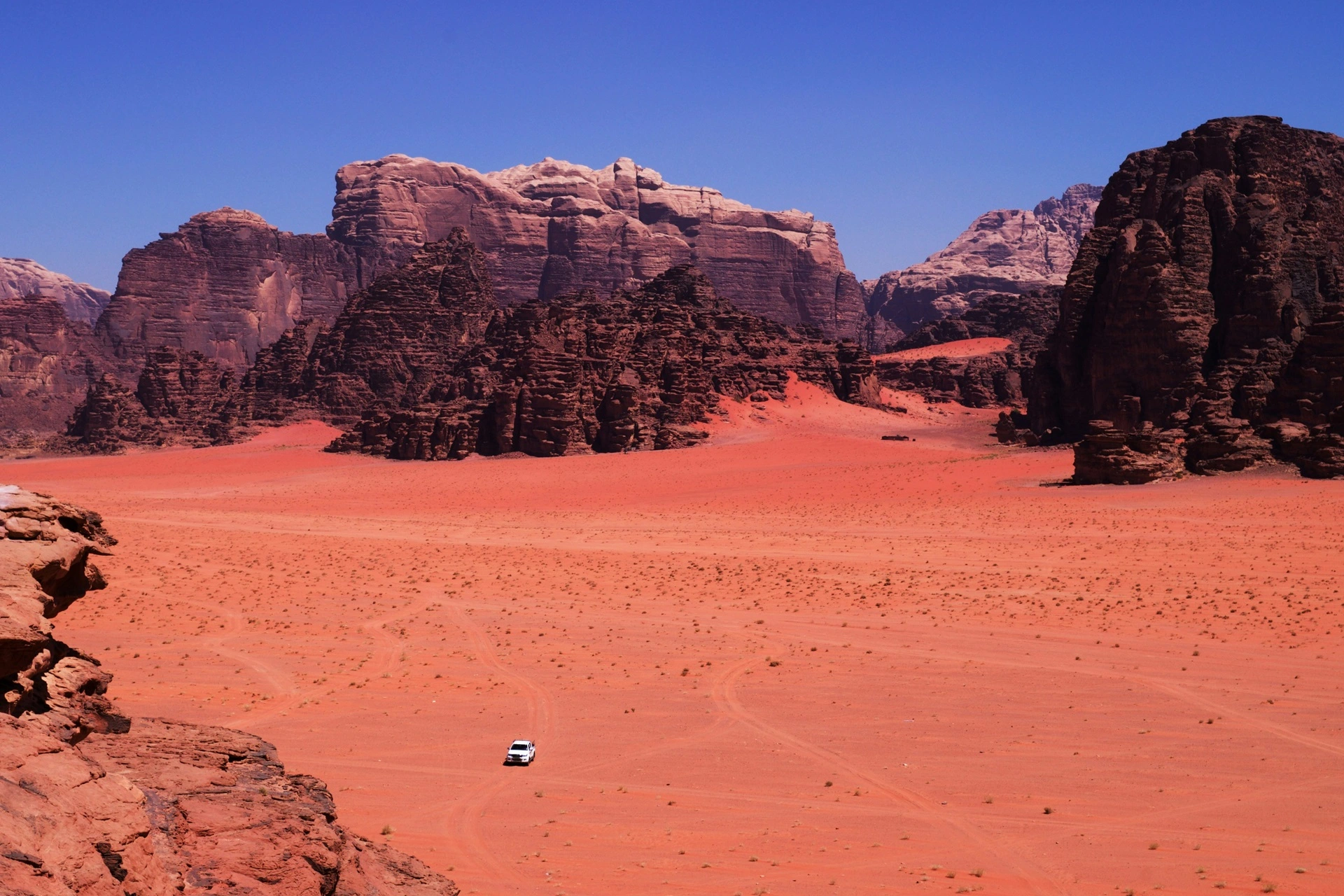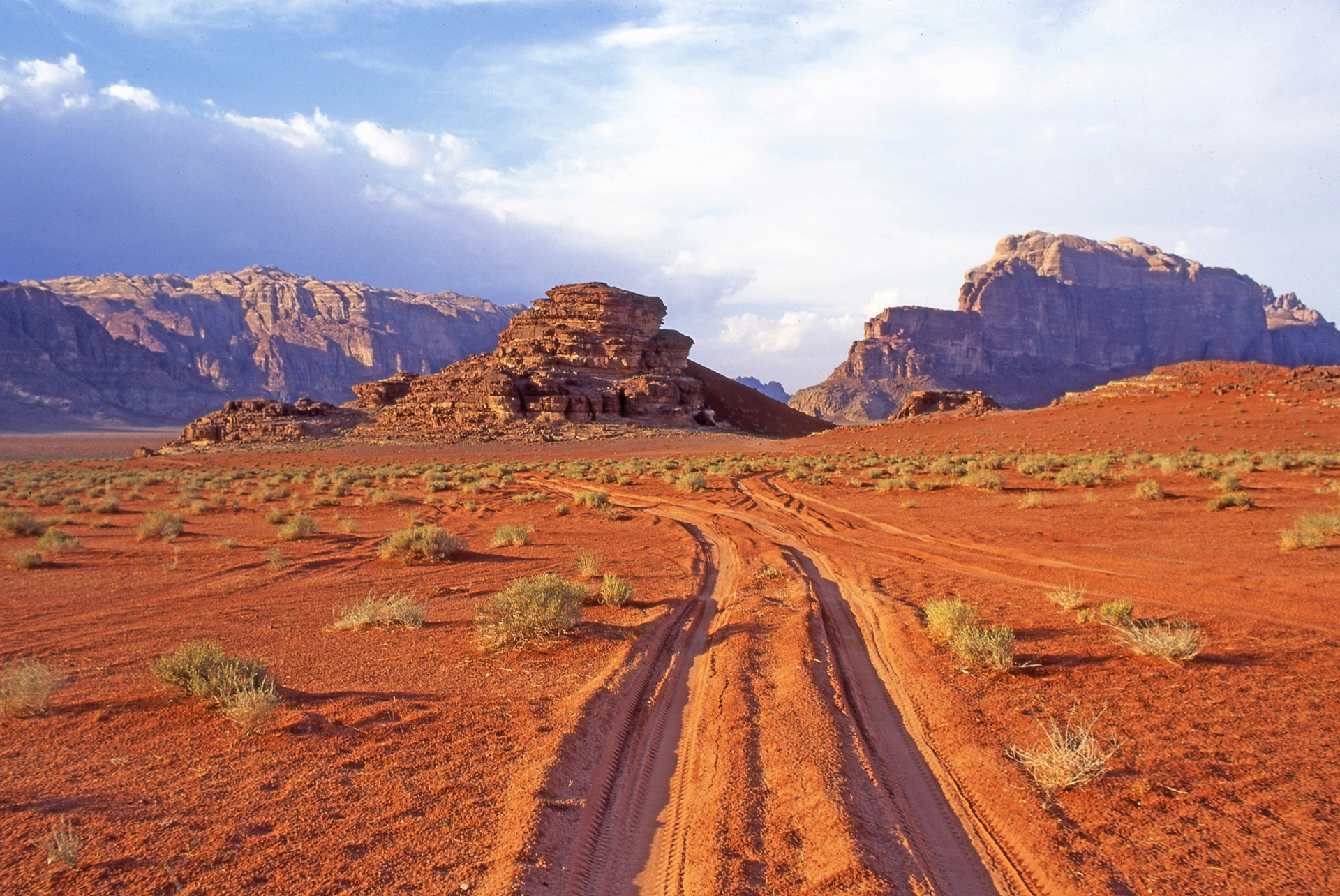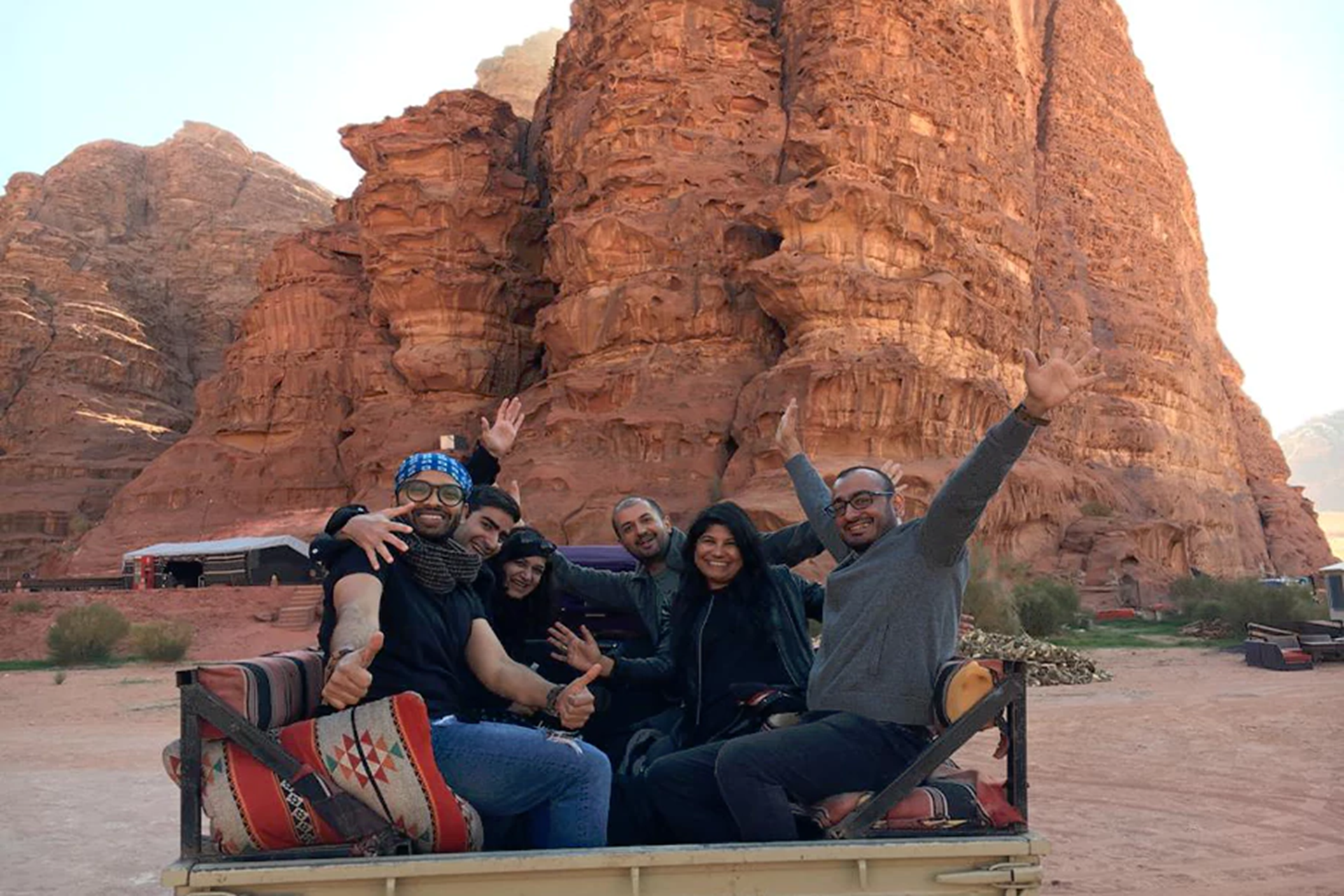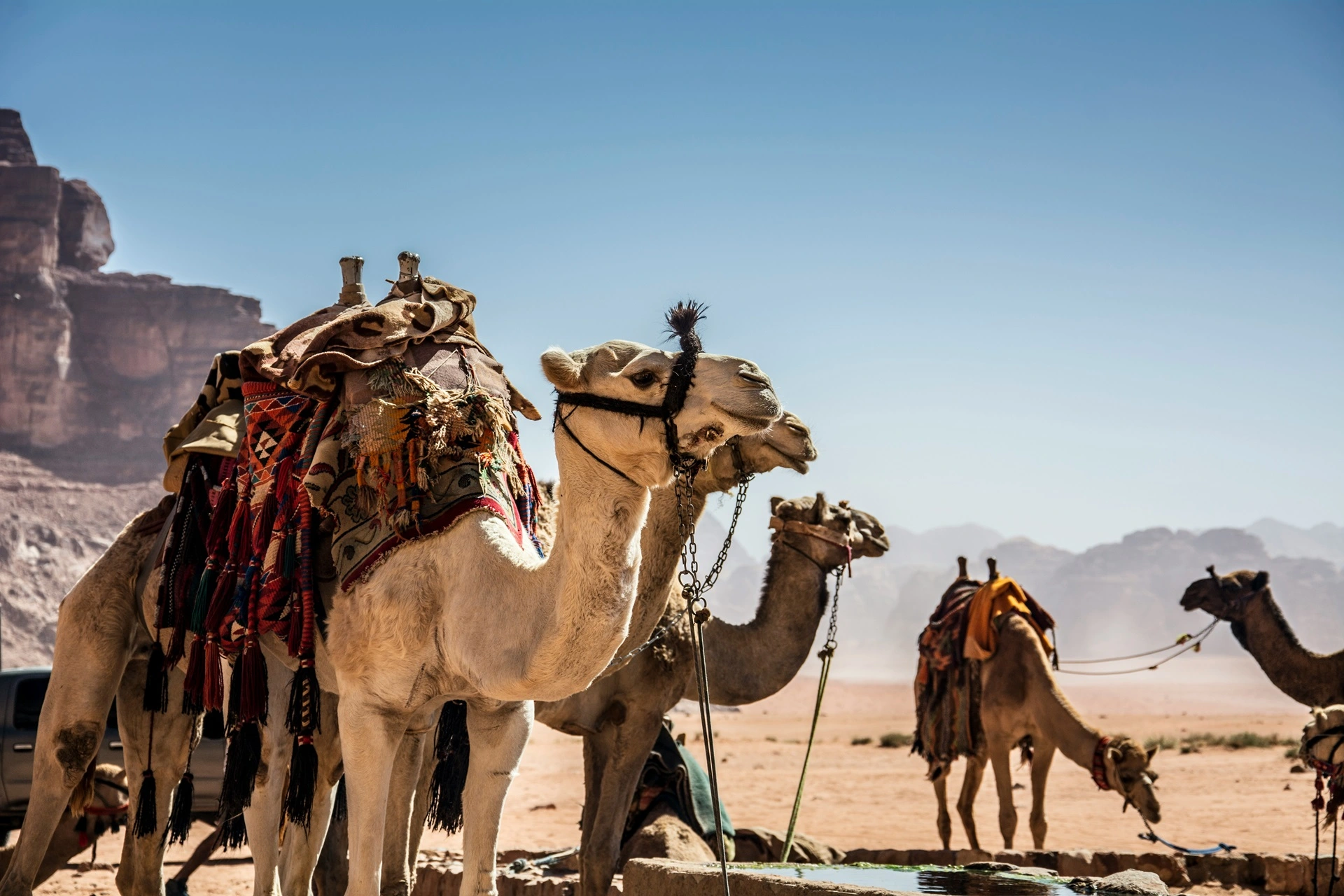Wadi Rum is one of the top attractions in Jordan. It is the largest wadi in Jordan and located in the southern part of the country, near the border with Saudi Arabia. In this article we provide information about things to do, where to spend the night, what to pack and more.
What makes Wadi Rum special?
Wadi Rum is not just a desert. It is a colourful landscape of mountains up to 1,800 meters high, canyons and rock formations. Besides, ancient rock carvings depicting animals and humans as well as inscriptions provide evidence of 12,000 years of human occupation. The desert had been home to farmers, hunters, herders and traders as caravan routes passed through Wadi Rum. Those carvings and inscriptions are one of the reasons why the 720 square km of the Protected Area of Wadi Rum had been declared a UNESCO World Heritage Site.
In the West Wadi Rum became known thanks to the 1962 movie “Lawrence of Arabia”. The film tells the story of the British officer T. E. Lawrence, who united the Arab tribes to fight against the Ottomans. During the Arab Revolt 1916 to 1918 Lawrence spent time in Wadi Rum and the movie had been partly shot in this desert. Wadi Rum was also the setting for films like Red Planet (2000), Theeb (2014), The Martian (2015), Aladdin (2019) and Dune (2021).
Driving Distances and Entrance Fee to Wadi Rum
Wadi Rum is about:
● 60 km or a one hours’ drive from Aqaba.
● 120 km or a 1.5 hours’ drive from Petra
● 325 km or a 4 hours’ drive from Amman or the Dead Sea.
Upon arrival, you must pay an entrance fee at Wadi Rum Visitor Centre. The fee is 7 Jordanian Dinar per international visitor. Children under 12 years do not pay any fee.
Best Time to Visit Wadi Rum
Spring and autumn are the best times to visit. From March to May and from mid September to November the weather is pleasant, and temperatures are not too high. Summertime lasts from June to August and daytime temperatures can be hot exceeding 40 degrees Celsius. If you cannot bear hot weather avoid this season. Activities like trekking are also not recommended in this period. December to February is wintertime in Jordan. Nights are chilly or even cold in this season, but daytime temperatures of about 10 to 15 degrees Celsius are ideal for longer outdoor activities like multi-day trekking. In winter there is the possibility of rainfall. Whenever you choose to visit Wadi Rum, there is a large difference between daytime and nighttime temperatures.
How much Time does one need in Wadi Rum?
The question how long you want to stay in the desert, depends on the time you have in Jordan and the activities you plan. Most clients with at least 5 days in the country opt for an overnight stay and a jeep ride, the fastest way to see the desert. We recommend staying overnight in the desert. As long as there are no clouds you will have the chance to experience the starry sky or enjoy a Bedouin meal like Zarb. Zarb consists of chicken or meat and vegetables cooked for several hours underground. In smaller campsites you can sit around a fireplace, get to know fellow guests or even your Bedouin host. Proper trekking or camel trekking requires a minimum 2-night stay in Wadi Rum. If you are short of time, you can also do a day trip from Petra, Aqaba or even Amman if you do not mind the long driving time from the capital.
Activities in Wadi Rum
There are many ways you can make your desert experience unforgettable, whether you plan to stay for a few hours, for one or even for several days. Below is just a list of popular activities you can go for on your visit to Wadi Rum. Certainly, you can combine several activities: ride camels, explore the desert in a jeep, hike and scramble up rocky terrain.
Jeep Tour
The easiest and fastest way to discover Wadi Rum is by 4x4 tour. Trips last from 2 to 8 hours and prices are fixed. For which duration you decide depends on how much time you have in the desert, and which sites you like to see. For instance, a 3-hour jeep ride covers the red sand dunes area, rock inscriptions and the Little Bridge. Longer 4x4 rides will give you the opportunity to see some of the less visited sites in Wadi Rum. During the drive you will stop at certain landmarks where you have time to take photos, stretch your legs or scramble to a viewpoint. 4x4s are operated by the local Bedouin cooperative. Most vehicles are old, converted pick-up trucks with a basic level of comfort. In the back of the pick-up are benches and seatbelts are not provided.
Camel Riding
If you want to do an authentic desert experience, don’t miss a camel ride. The Arabian camels have only a single hump and without these incredible animals, journeys across the desert would not have been possible in the past. The slow pace of a camel ride offers a different way to explore the desert. A camel ride can range from just 30 minutes to a several days camel trek. Short camel rides can be taken at any time of the day, for example a 1-hour sunset ride is popular. Full day camel tours start at 10:00 in the morning, after a few hours you will enjoy a long lunch break before you continue the ride in the afternoon. Camel handlers often have limited English skills. Keep in mind as well, camel rides are not suitable for pregnant women and people with back problems.
Horse Riding
Wadi Rum is a good destination for horse riding. Arabian horses had been the companion of Bedouins in a harsh environment and are part of their culture. You can choose tours for 3 hours up to 6 days. But you need to be an advanced rider and able to control horses in walk, trot and canter. Because summer temperatures are high, horse riding tours are best arranged from mid September until May. As horses are light framed the weight of the rider is limited to 85 kg. For multiday rides basic camps are set up each night at a different location in the desert. Naturally, you will be accompanied by a Bedouin riding guide knowing the horses and the desert of Wadi Rum. Advance booking is needed.
Hiking, Trekking & Scrambling
Exploring Wadi Rum on foot is the perfect way to take in all the sights and sounds of the desert. A wide range of trails is available. From self-guided short and easy hikes like through Abu Khashabah canyon up to several day treks with a Bedouin guide following traditional routes of nomads and taking you from place to place. For certain trails you need to be fit, healthy and have no fear of heights, as you need to scramble and climb and on multiday treks you will sleep in bivouac camps with a basic level of comfort. Popular are day trips to hike and scramble to Burdah Rock Bridge or to the top of Jabal al Hash or Jabal Umm Ad Dami, with 1,854 meters the highest mountain in Jordan.
Hot Air Balloon Ride
In Wadi Rum hot air balloon rides are offered so you can see the beauty of the desert with its different coloured rocks and valleys from above. Flights operate in the early morning only, starting with sunset. Therefore, it is best to stay the night before in Wadi Rum as you need to get up early. After arriving by jeep to the launching site, you will see how the balloon is prepared, and your pilot will give you a safety briefing. The flight can take you to heights of up to 2,000 feet and lasts about one hour. But for the whole experience you should allow 2 to 3 hours. Other visitors will join you on the flight. Keep in mind that hot air balloon rides can be cancelled last minute if weather conditions do not guarantee a safe flight.
Quad Bike Ride
Another fun activity in the desert is a quad bike ride through the stunning landscapes of Wadi Rum in Jordan. You will drive over mudflats, reach special rock formations, and a few challenging sand dunes. Your guide will provide you with advice and guidance on how to drive a quad bike. Hop on an ATV bike and follow your guide on a private 1-hour outing. The minimum age to drive a quad bike is 18 years. This experience provides all necessary equipment, including safety helmets. Choose between morning, afternoon, and evening rides.
Stargazing & Perseid Meteor Shower
As long as there are no clouds, Wadi Rum is a great location for stargazing due to no light pollution.
You simply can marvel at the night sky within your campsite or book a guided program to learn about stars, planets and the Milky Way. On an organized tour telescopes will give you the opportunity of a closer look at the cosmos. Every year the Perseid Meteor Shower can be observed. Wadi Rum is a good location to do so. This year, 2025, the peak is expected in the night from 12. to 13. August.
Hejaz Train Ride
From 1900 to 1908 the Ottomans constructed the Hejaz Railway and established a train connection between Damascus and the holy city of Medina. Part of the railway still exists in Wadi Rum. On Sunday and Wednesday afternoon you can board a steam train for a 14 km ride while a historic episode of the Great Arab Revolt of 1916 is resembled. While riding on the train with Ottoman soldiers providing supplies for the nearby garrison, Arab fighters will ambush the train in Wadi Rum.
Packing Tips: What to Wear in Wadi Rum
As Jordan is a Muslim country the general rule is to cover knees and shoulders. In addition, when packing for Wadi Rum you need to consider the protection from sun, sand, wind, high and low temperatures. The basics are covering clothes, hat, scarf, sun cream and sunglasses and comfortable shoes. When staying for the night or several days in the desert, dressing in layers is recommended. So, you can adapt to changing temperatures and dress accordingly. Hiking and scrambling tours require strong shoes. For a stay at a smaller Bedouin Camp bring a torch light, a small towel and a sleeping sheet. More items you need when deciding for wild camping: sleeping bag, warmer clothes for the cooler nights, antibacterial hand wash, toilet paper and waste bags, camera with batteries or a power bank. Depending on the campsite, the time you spend in the desert and your chosen activities you can store larger pieces of luggage at the campsite or in an office in Rum Village. For trekking tours, bring a small backpack for your daily needs during the tour and overnight stay. There is no bank or ATM in Wadi Rum. Hence, bring cash as not all services can be paid for with a credit card.
Overnight Stay in Wadi Rum
As there are hundreds of camps in Wadi Rum, it is not an easy task to decide where to spend the night. To narrow down the options consider your budget, how much comfort and what kind of atmosphere you expect. You can stay in a small campsite, located deeper in the desert getting closer to the traditional Bedouin culture. This means you will have your private sleeping tent with simple beds and bathrooms with shared toilets and showers. You can also take your mattress out of the tent and sleep under the stars. Meals will be served in a communal tent. If you want more comfort, you will find many camps offering private tents with en suite bathroom and air conditioning. Since several years so-called Martian Tents or Bubble Tents are very popular. A part of this tent type is transparent to observe the desert or the night sky. For real desert adventures like trekking and camel trekking it is the best experience to spend the night at wild camps. This means the tents are just set up for you. Water for washing will be provided, but there are no toilets around. Your Bedouin guide will do the cooking.
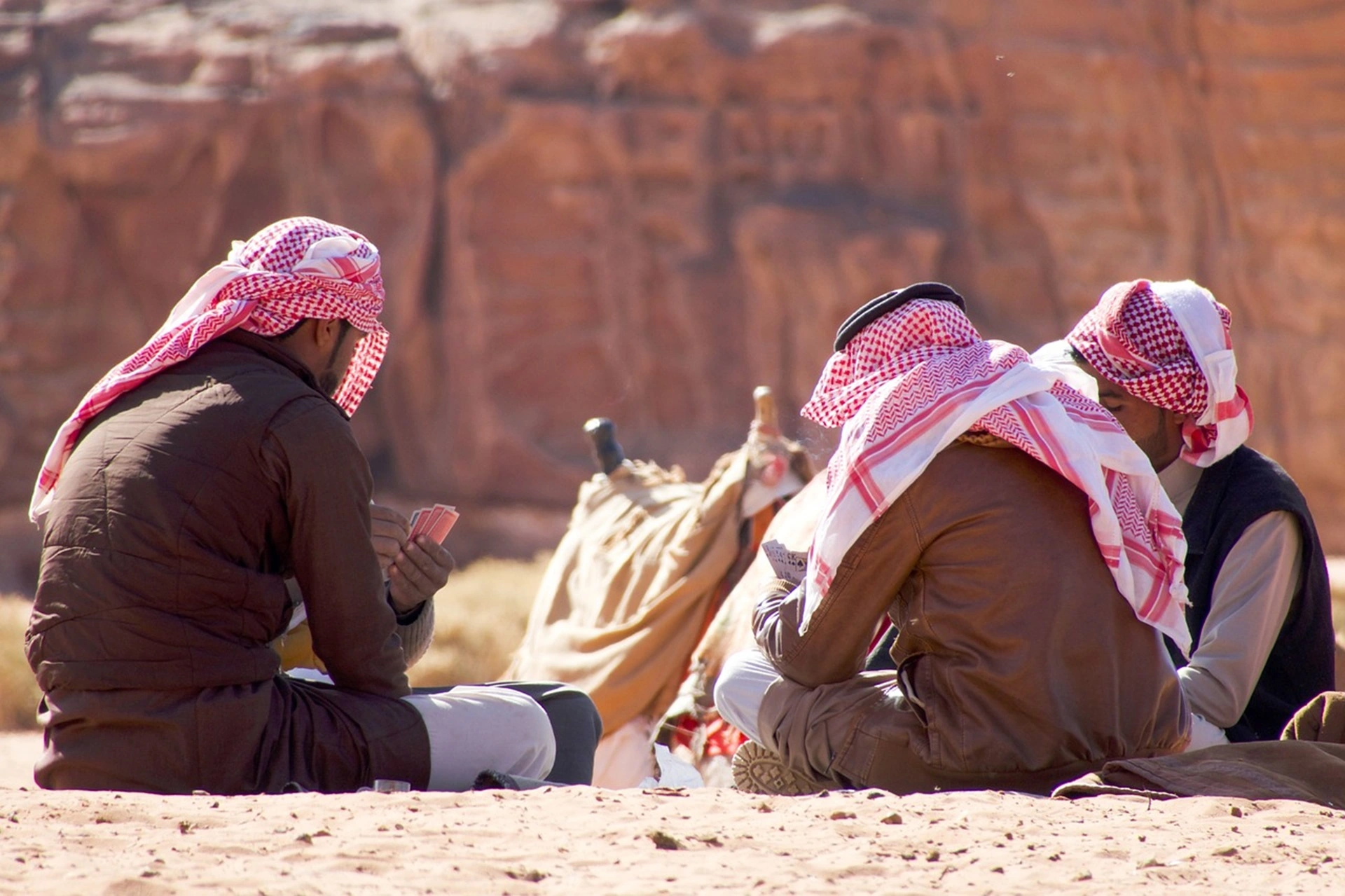
Bedouin Culture
Most people living in Wadi Rum are Bedouins. Their ancestors led nomadic lives, relying on goat and sheep herds, camel breeding and practicing agriculture if rainfall allows. Nowadays Bedouins settled down and live in villages like Rum Village, Diseh and Shakriya. They organize jeep and camel rides or run touristic campsites. But the traditional Bedouin lifestyle keeps on influencing the mentality. Hospitality is a great aspect of desert life. In a harsh environment where few people live, hospitality and generosity are important. Furthermore, the Bedouin society consists of different tribes with a Sheikh for each tribe, responsible for solving issues within the community.
Places to Visit in Wadi Rum
Here we list a selection of some popular attractions you can see in Wadi Rum as part of your Jordan tour. When planning what places to visit it is important to consider the locations due to the vastness of the Protected Area. For day tours picnic lunches or lunch boxes are included.
Seven Pillars of Wisdom
The Seven Pillars of Wisdom is the name of a mountain known by locals as Jabal Al Mazmar. The new name has been given in the memory of T. E. Lawrence’s book with the same name. Lawrence of Arabia, fighting in the Arab Revolt against the Ottoman Empire, describes here the natural beauty of Wadi Rum. The mountain lies opposite the Visitor Centre, so all guests to Wadi Rum will not miss the view of this interesting rock formation.
Lawrence Spring
As the name suggests, Lawrence Spring was also named after Lawrence of Arabia. Bedouins know the place as Ain Abu Aineh, about 3 km of Rum Village. Nowadays the spring is very small, as a drainage system redirects the water to a reservoir. But still the spring offers from the top nice vistas over the surroundings. To reach the spring you need to scramble over rocks. You find here also rocks with Thamudic inscriptions. The site is a regular stopping point of jeep tours.
Khazali Canyon
A narrow passage takes you into the Khazali Canyon, famous for its many rock inscriptions. The walls are covered with Thamudic, Nabatean and Islamic rock inscriptions as well as rock carvings depicting humans and animals such as ibex. Inside the canyon you find water basins where rain has been collected. Like in ancient times the towering walls offer shade and coolness from the desert sun. The canyon can be visited on jeep tours of at least 2 hours and longer.
Anfashieh Inscriptions
If you want to see more rock inscriptions and petroglyphs, include in your tour a visit to Anfashieh. At one of the walls of this mountain you find inscriptions made by the Thamuds and the Nabateans, both tribes of the Arabian Peninsula. Those inscriptions are more than 2,000 years old. Beside the petroglyphs you see drawings of symbols, camels in different sizes, animals, humans, and caravans.
Red Sand Dunes
In Wadi Rum you find several sand dunes, formed by wind and often piled up against the mountains. One of the highlights are the red sand dunes. Their particular colour comes from iron oxide coating on the sand grains. You will have time to climb to the top of the dune, enjoy the great panoramic views of the surroundings before you walk or run down the dune back to the jeep. If you want to have some fun, try sandboarding over the soft sand.
Little Bridge
The erosion from gravity, sand and temperature variation formed over time several natural rock bridges in Wadi Rum. The smallest rock arch is the Little Bridge, which is about 4 meters long. Even for people with a fear of heights, the Little Bridge is easy to climb. On top of the arch enjoy some great vistas over the desert, particular the valley of Khor Al Ajram. On a 3-hour jeep ride Little Bridge can be included and it is a popular stop for visitors.
Um Frouth Rock Bridge
Um Frouth is the second highest rock arch in the Protected Area of Wadi Rum. It rises 15 meters from the desert floor and this natural phenomenon is a massive structure of stone. It takes a moderate climb including scrambling without gear, along a rocky edge, to the top of the rock bridge. You will be rewarded with amazing views. Um Frouth is one of the most photographed places in Wadi Rum and can be included in a 3.5 hours’ jeep tour.
Burdah Rock Bridge
With 35 meters Burdah is the highest rock bridge. If you are fit, have no fear of heights and like to do a little adventure you can make it up to the summit with the help of a Bedouin guide. The climb includes a difficult section of rock climbing and the whole experience up and down the bridge takes about 3.5 to 4 hours. If you just want to see Burdah book a 4-hour jeep ride. For a hike up to the top of the bridge you’ll have to consider a one-day tour.
Mushroom Rock
Not far away from Burdah Bridge one of the unusual rock formations in Wadi Rum can be seen: the Mushroom Rock. The forces of nature created in the desert unique rock shapes and formations by erosion, and this is one of them. As the name suggests, this rock resembles a mushroom. It is a popular photo spot for visitors to Wadi Rum and offers also an opportunity to rest in the shade of its cap.
Barrah Canyon
One of the popular canyons in Wadi Rum for an easy hike is the Barrah Canyon. The route is about 5 kilometres long and the hike takes about 2 hours. You will discover on your way big sand dunes, rock architecture and in a side canyon a Nabatean dam. In the early morning and late afternoon the sun turns the rocks into an orange colour. When walking inside the canyon, you will pass by a famous rock climbing wall with fixed rings and ropes along the trail.
Abu Khashabah Canyon
If you are in the area of Umm Frouth or Burdah Bridge and have some time, enjoy a walk through Abu Khashaba Canyon. It takes about 45 minutes to cross the complete gorge. You will be dropped off at one side of the canyon and meet your jeep driver again at the other side of Abu Khashabah. Inside the pleasant canyon you will see red and yellow sand, green bushes, interesting sandstone formations and enjoy some cooling off.
Jabal Umm Ad Dami
The highest mountain in Jordan is with 1,854 meters Jabal Umm Adami. You find the mountain in Wadi Rum at the border with Saudi Arabia. You can have a great day out by climbing and scrambling to the top with a Bedouin guide. Drive about 1.5 hours, crossing Wadi Saabit, to reach the area. It is a moderate hike, you need up to 4 hours to the top and back to the ground. Your efforts will be rewarded with amazing views in all directions.
